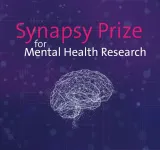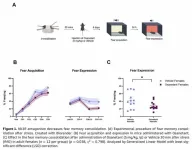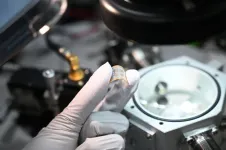(Press-News.org) (Philadelphia, PA) – Calcium transport into and out of mitochondria – the powerhouses of cells – is central to cellular energy production and cell death. To maintain the balance of calcium within these powerhouses, cells rely on a protein known as the mitochondrial sodium-calcium exchanger, or NCLX. Now, in new research, scientists at the Lewis Katz School of Medicine at Temple University have discovered a novel regulator of NCLX activity, a protein called TMEM65, which helps move calcium out of mitochondria, protecting against harmful calcium overload.
The discovery, described online April 8 in the journal Nature Metabolism, is the first to characterize the interaction of TMEM65 with NCLX in mitochondria. “TMEM65 is the first protein identified that is a bona fide interactor and regulator of NCLX,” explained John W. Elrod, PhD, W.W. Smith Chair in Cardiovascular Medicine and Founding Director of the Aging + Cardiovascular Discovery Center at the Lewis Katz School of Medicine and senior investigator on the new study. The discovery could help scientists design new therapeutic agents to combat calcium overload of mitochondria in conditions such as heart failure and Alzheimer’s disease.
Mitochondrial calcium exchange serves a critical part in regulating cell survival and pro-energetic signaling pathways. When mitochondria take in too much calcium, which can happen in certain disease states, energy metabolism is disrupted and cells die. This is most apparent in the heart, where calcium overload contributes to the permanent loss of heart muscle cells during heart attacks and in heart failure. It also can result in the loss of brain cells in Alzheimer’s disease and other neurodegenerative conditions.
Dr. Elrod and colleagues previously identified NCLX as a key player in the removal of calcium from mitochondria in the heart and brain. Research has also shown that augmenting NCLX activity can limit the progression of not only heart failure and Alzheimer’s disease but also cancer. Nonetheless, despite these promising findings, an understanding of the mechanisms underlying NCLX regulation has remained elusive.
“NCLX has a very complex structure, which has impeded the study of its regulation and hindered progress in therapeutic development,” Dr. Elrod said. “For our latest study, we decided to take a different approach, using biotin tagging, which allowed us to trace NCLX’s interactions with other proteins in intact cells.”
Led by postdoctoral fellow Joanne F. Garbincius, PhD, Dr. Elrod’s team generated a fusion of NCLX and a biotinylation protein. The fusion protein was then placed back into cells, and other proteins that came within its proximity were biotinylated, or biochemically labeled. The biotinylated molecules were then easily isolated, enabling their identification with mass spectrometry. In this way, the researchers ultimately discovered TMEM65 as a primary suspect in NCLX regulation.
“TMEM65 was of particular interest because it is a mitochondrial protein of unknown function,” Dr. Elrod explained. “We also knew about a case report in which a young girl with a loss-of-function mutation in TMEM65 experienced profound muscle weakness and microcephaly (abnormally small head/brain) and neurological dysfunction.”
In subsequent experiments, it was discovered that when TMEM65 is removed from cells, calcium levels in the mitochondria accumulate. This led to the realization that TMEM65 is required for NCLX activity. Its role in regulating NCLX was confirmed in a mouse model in which TMEM65 levels were significantly decreased. As animals matured, they experienced a progressive loss of neuromuscular function, to the extent that they could barely walk by adulthood.
The methods used to identify TMEM65 and to elucidate NCLX regulation are groundbreaking in the field of basic cardiovascular science. In 2024, Dr. Garbincius was recognized for her research with the prestigious American Heart Association’s Louis N. and Arnold M. Katz Basic Science Research Prize for Early Career Investigators.
The work has also inspired ongoing investigation of TMEM65. Dr. Elrod and colleagues plan next to explore the possibility of modulating TMEM65 activity as a therapeutic strategy. “TMEM65 is a promising therapeutic target,” Dr. Elrod added. “Figuring out how to augment or otherwise alter its interaction with NCLX could offer an important treatment option for patients affected by diseases involving pathogenic calcium buildup in mitochondria.”
Amy J. Goldberg, MD, FACS, The Marjorie Joy Katz Dean of the Lewis Katz School of Medicine, emphasized the significance of this research, stating, “This discovery exemplifies the transformative science happening at the Lewis Katz School of Medicine. By deepening our understanding of mitochondrial function, our researchers are paving the way for innovative treatments that could have a profound impact on patients with heart failure, Alzheimer’s disease, and beyond.”
Other researchers involved in the study include Oniel Salik, Henry M. Cohen, Carmen Choya-Foces, Adam S. Mangold, Angelina D. Makhoul, Anna E. Schmidt, Dima Y. Khalil, Joshua J. Doolittle, Anya S. Wilkinson, Emma K. Murray, Michael P. Lazaropoulos, and Alycia N. Hildebrand, Aging + Cardiovascular Discovery Center, Department of Cardiovascular Sciences at the Lewis Katz School of Medicine; and Dhanendra Tomar, Department of Internal Medicine, Wake Forest University School of Medicine, Winston-Salem, North Carolina.
The research was supported in part by funding from the National Institutes of Health and the American Heart Association.
About the Lewis Katz School of Medicine
Founded in 1901, the Lewis Katz School of Medicine at Temple University attracts students and faculty committed to advancing individual and population health through culturally competent patient care, research, education, and service. The School confers the MD degree; MS and PhD degrees in Biomedical Science; the MA in Urban Bioethics; the MS in Physician Assistant studies; a certificate in Narrative Medicine; a non-degree post-baccalaureate program; several dual degree programs with other Temple University schools; continuing medical education programs; and in partnership with Temple University Hospital, 40 residency and fellowship programs for physicians. The School also manages a robust portfolio of publicly and privately funded transdisciplinary studies aimed at advancing the prevention, diagnosis, and treatment of disease -- with specialized research centers focused on heart disease, cancer, substance use disorder, metabolic disease, and other regional and national health priorities. To learn more about the Lewis Katz School of Medicine, please visit: medicine.temple.edu.
END
Discovery of mitochondrial protein by researchers at Lewis Katz School of Medicine at Temple University opens path to therapeutic advances for heart and Alzheimer’s disease
2025-04-08
ELSE PRESS RELEASES FROM THIS DATE:
Recognizing the bridge builders between neuroscience and psychiatry
2025-04-08
Mental health is in crisis worldwide. While the neurosciences are advancing rapidly, psychiatry still struggles to diagnose and effectively treat many disorders. The Synapsy Center for Neuroscience and Mental Health Research at the University of Geneva, Switzerland, is launching a new international prize to reward those who bring these two worlds closer together.
A new research model is needed
Depression, schizophrenia, anxiety or bipolar disorders: psychiatric illnesses affect hundreds of millions of people worldwide and are among the leading causes of disability, suffering and mortality. Yet clinical advances remain limited. Many diagnoses ...
Lactic acid bacteria can improve plant-based dairy alternatives
2025-04-08
A new study maps how specific lactic acid bacteria can enhance both the flavour and nutritional quality of plant-based dairy alternatives. The findings may have wide-reaching perspectives for the further development of sustainable foods.
Plant-based dairy alternatives – such as soy, oat, and almond drinks – are produced without animal ingredients for consumers seeking plant-based substitutes for milk and yoghurt. However, many of these products have the similar shortcomings: flavours that do not always appeal ...
Public housing smoking ban reduced heart attacks and strokes
2025-04-08
A new paper in Nicotine & Tobacco Research, published by Oxford University Press, finds that a 2018 U.S. ban on smoking in public housing led to a reduction in hospitalizations for cardiovascular problems.
Tobacco use and exposure to secondhand smoke is a leading cause of preventable death in the United States. Some 480,000 Americans die every year due to tobacco. While the prevalence of adults exposed to secondhand smoke decreased dramatically between 1988 and 2014 (from 87.5% to 25.2%), about 58 million non-smokers in the U.S. experience tobacco smoke, primarily at home. Beginning in the early 2000s, ...
Positron emission tomography in psychiatry: Dr. Romina Mizrahi maps the molecular future
2025-04-08
MONTRÉAL, Québec, Canada, 8 April 2025 – In a powerful and deeply reflective Genomic Press Interview, published in Brain Medicine, Dr. Romina Mizrahi, Professor of Psychiatry at McGill University and Principal Investigator of the CaTS (Clinical and Translational Sciences) Lab at the Douglas Research Center, charts a new path forward in psychiatric research—one that begins at the molecular level.
Harnessing the power of positron emission tomography (PET), Dr. Mizrahi’s work sheds light on the invisible workings of the human brain. Where traditional psychiatric diagnosis often relies on subjective symptom clusters, her approach integrates in-vivo imaging, ...
Post-trauma drug blocks fear response in female mice, study shows
2025-04-08
BARCELONA, Catalonia, Spain, 8 April 2025 – A new Brevia (peer-reviewed research report) published in Brain Medicine reveals that a single dose of the drug Osanetant, administered shortly after a traumatic event, significantly dampens fear expression in female mice. The findings provide strong preclinical support for using Nk3R antagonism as a sex-specific, time-sensitive intervention to reduce the risk of posttraumatic stress disorder (PTSD).
Targeting fear memory at its roots
Fear memory is a core feature of PTSD, especially when neutral cues become emotionally ...
Trees could be spying on illegal gold mining operations in the Amazon rainforest
2025-04-08
For hundreds of years, the Amazon has been exploited for its gold. Today, the precious metal is just as sought after, but the remaining tiny gold particles are much harder to find. Mining often happens in artisanal and small-scale mining operations that release mercury (Hg) into the air, polluting the environment and harming human health.
An international team of researchers has now examined tree rings of species native to the Peruvian Amazon to determine if trees could be used to show approximately where and when atmospheric mercury was released.
“We show that Ficus insipda tree cores can be used as a biomonitor for characterizing ...
Even after a thousand bends, performance remains uncompromised!
2025-04-08
The research team led by Dr. Jongwon Yoon, Dr. Jeongdae Kwon, and Dr. Yonghoon Kim from the Energy & Environmental Materials Research Division at the Korea Institute of Materials Science (KIMS), has successfully developed the world’s first ammonia (NH₃) gas sensor based on a copper bromide (CuBr) film that can be fabricated through a simple solution process at low temperatures. This breakthrough technology not only enables sensor flexibility, ultra-sensitivity, and high selectivity but also significantly reduces manufacturing costs.
Ammonia gas sensors detect airborne ammonia and are utilized in indoor and outdoor ...
Survey: Women’s perceptions of perimenopause
2025-04-08
Hot flashes, mood swings, weight gain and insomnia are all signs of hormonal changes and symptoms of menopause, when a woman no longer has menstrual cycles. They can also signal perimenopause, when the body is preparing for this next season of life.
“Perimenopause is when the menstrual cycle has started to change, and it is persistent,” explained Lauren Baker, DO, an obstetrics and gynecology physician at The Ohio State University Wexner Medical Center and certified practitioner with the Menopause Society. “The formal definition is periods fluctuate by at least seven days for at least 10 months.”
A new survey by Ohio State ...
Singapore scientists pioneer non-invasive 3D imaging to transform skin cancer management
2025-04-08
SINGAPORE – Researchers from the Agency for Science, Technology and Research (A*STAR) and the National Healthcare Group (NHG) have jointly pioneered an innovative imaging technique combining Multispectral Optoacoustic Tomography (MSOT) with artificial intelligence (AI) that could significantly improve the diagnosis and treatment of basal cell carcinoma (BCC), the most common form of skin cancer worldwide.
This advanced technique uses photoacoustic imaging (PAI), enhanced by an automated segmentation algorithm, to provide real-time, high-resolution, three-dimensional (3D) images of skin tumours. By accurately mapping tumour boundaries, ...
Powerful new tool promises major advances in cancer treatment
2025-04-08
New Australian technology is set to transform the way that gastrointestinal cancers are detected and treated with precise, minimally invasive surgery.
Backed by the Federal Government’s Economic Accelerator (AEA) Ignite Grant, researchers from the University of South Australia (UniSA) are using quantum technology to develop a first-of-its-kind laparoscopic probe that will allow surgeons to accurately map the spread of tumours.
The technology has the potential to improve cancer survival rates and patient quality of life worldwide.
Led by Dr Nicole Dmochowska from UniSA’s ...






